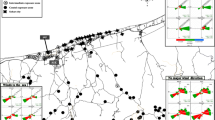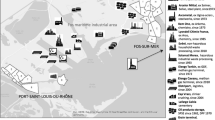Abstract
Objectives This report summarizes the results of a cross-sectional study in Cameron Park in 2000–2001 to identify disease prevalence and health concerns among colonia residents and to identify environmental exposures to potentially adverse environmental conditions. Results Asthma and allergies were among the most prevalent respiratory diseases reported in both adults and children of Cameron Park. Other diseases affecting the community in higher numbers included diabetes and heart disease/high blood pressure. Among children, the most prevalent health conditions were asthma, followed by lung diseases, allergies, and to a lesser degree, skin rashes. Conclusions These data can be useful in developing education and intervention programs to address the public health and medical issues impacting residents in the Cameron Park Colonia of Texas.
Similar content being viewed by others
References
Environmental Protection Agency (EPA). The 1997 United States-Mexico border environmental indicators report. Washington, D.C: EPA Press; 1997.
Schmidt CW. Bordering on environmental disaster. Environ Health Perspect. 2000;108(7):A308–15.
May ML, Bowman GJ, Ramos KS, et al. Embracing the local: enriching scientific research, education, and outreach on the Texas–Mexico Border through a participatory action research partnership. Environ Health Perspect. 2003;111(13):1571–6.
U.S. Environmental Protection Agency (EPA). Appendix 8: social and economic overview of the U.S.-Mexico border. U.S.-Mexico border XXI Frontera XXI Website. 2001; Available: http://www.epa.gov/usmexicoborder/2001/ef.htm (accessed 23 Jan 2003).
Witmer A, Seifer SD, Finochio L, Leslies J, O’Neail EH. Community health workers: integral members of the health care work force. Am J Public Health. 1995;85(8):1055–8.
Texas-Mexico Border Health Coordination Offices. Texas–Mexico border counties 1998: demographics and health statistics. Edinburg, TX: University of Texas System; 1998.
Ramos IN, May M, Ramos KS. Environmental health training of promotoras in colonias along the Texas–Mexico border. Am J Public Health. 2001;91(4):568–70.
Department of Health and Human Services. United States-Mexico Border Priority Program. Washington, D.C: DHHS; 1997.
U.S. General Accounting Office. U. S.-Mexico border: issues and challenges. Confronting the United States and Mexico. Report to congressional requesters. Washington, D.C: Government Printing Office; 1999.
Ariel Cisneros, “Texas Colonias: housing and infrastructure issues”. Available: http://www.dallasfed.org/research/border/tbe_cisneros.html (accessed 16 Aug 2006).
U.S. Census Bureau, 2002. Available: http://www.dataplace.org/area_overview/index.html?place = p26.10:4812045&z = 1[accesses15April2003] and http://www.dataplace.org/area_overview/index.htlm. (accessed 8 Aug 2003).
U.S. National Health and Nutrition Examination Survey, Centers for Disease Control and Prevention. Available: http://www.cdc.gov/nchs/nhanes.htm (accessed 5 Jun 2006).
U.S. National Health Interview Survey, National Center of Health Statistics. Available: http://www.cdc.gov/nchs/nhis.htm (accessed 5 Jun 2006).
Andrys C, Hanovcova I, Chylkova V, Tejral J, Eminger S, Prochazkova J. Immunological monitoring of dry-cleaning shop workers—exposure to tetrachloroethylene. Cent Eur J Public Health. 1997;5(3):136–142.
Patrick L. Lead toxicity, a review of the literature. Part I: exposure, evaluation, and treatment. Altern Med Rev. 2006;11(1):2–22.
English PB, Von Behren J, Harnly M, Neutra NN. Childhood asthma along the United States/Mexico border: hospitalizations and air quality in two California counties. Rev Panam Salud Publica. 1998;3(6):392–9.
Houston Institute for Culture—The Border. Available: http://www.houstonculture.org/border/col.html (accessed 16 Aug 2007).
Dutton RJ. Survey of health and environmental conditions in Texas border counties and colonias. Office of Border Health, 2000 Available from http://www.dshs.state.tx.us/borderhealth/publications_reports.shtm.
EPA and SEMARNAT. United States-Mexico Border Environmental Indicators 1997, EPA/909/R-98/001. US Mexico Border XXI Program, EPA, 1997, 5 Available from http://www.epa.gov/border2012/inica97/1997report.pdf.
Acknowledgements
This work was supported by the National Institute of Environmental Health Sciences (NIEHS), NIH grant numbers P30 ES09106 and 5-T32 ES07262–12. We acknowledge the technical assistance of Ms. Teresa Serna during the data collection phases of this project.
Author information
Authors and Affiliations
Corresponding author
Rights and permissions
About this article
Cite this article
Ramos, I.N., Davis, L.B., He, Q. et al. Environmental Risk Factors of Disease in the Cameron Park Colonia, a Hispanic Community Along the Texas–Mexico Border. J Immigrant Minority Health 10, 345–351 (2008). https://doi.org/10.1007/s10903-007-9087-1
Published:
Issue Date:
DOI: https://doi.org/10.1007/s10903-007-9087-1




